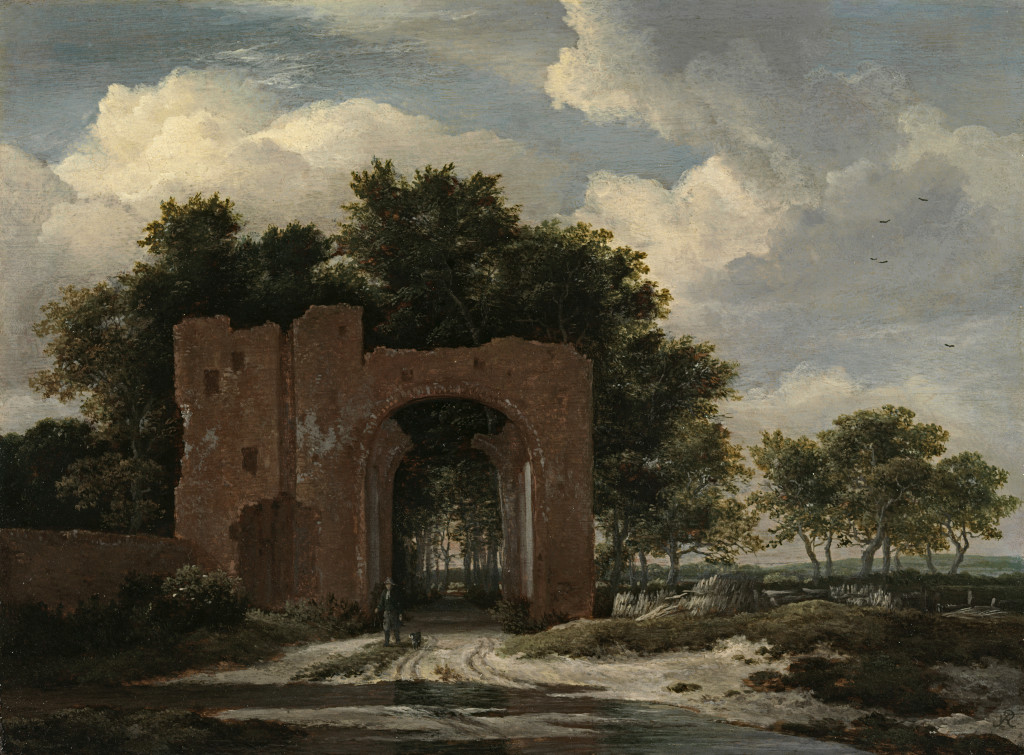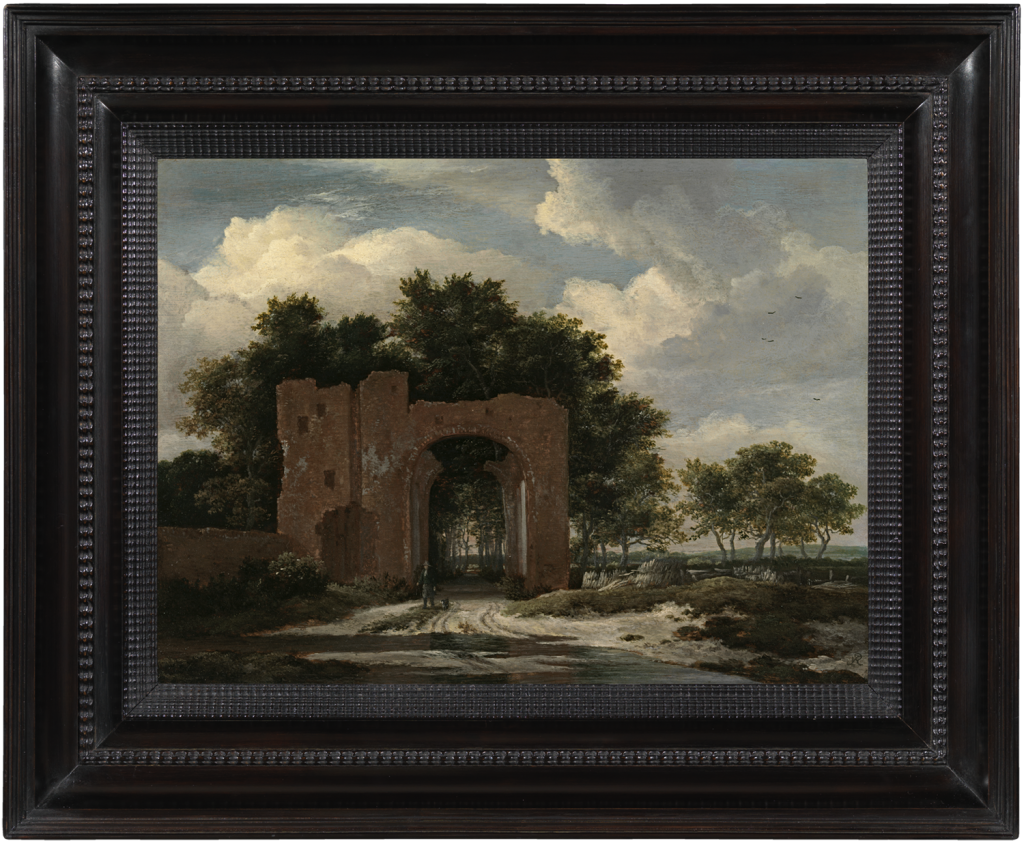JACOB ISAACKSZ. VAN RUISDAEL
Haarlem 1628/9 - 1682 Amsterdam
Ref: BJ 2
A ruined castle gateway
Signed in monogram lower right: JR
Oil on panel: 10 7/8 x 14 ¾ in / 27.6 x 37.5 cm
Frame size: 16 ½ x 20 ½ in / 41.9 x 52.1 cm
Painted circa 1650-1655
Provenance:
Sir Francis Cook, 1st Bt., Visconde de Monserrate (1817-1901), Doughty House, Richmond, Surrey, by 1901;
Sir Frederick Cook, 2nd Bt. (1844-1920), Richmond;
Sir Herbert Cook, 3rd Bt. (1868-1939), Richmond;
Sir Francis Cook, 4th Bt. (1907-1978), Richmond;
from whom acquired by Nathan Katz, Dieren (possibly in association with Agnew’s), summer 1939;
sold through Walter Andreas Hofer to Hermann Goering, 1940;
by whom sold through Hofer for RM 250,000, along with eight other paintings, to
Philipp Reemtsma, Hamburg, in September 1940;
recovered by Allied Forces in November 1946 from Haus Neuerburg, Munich and sent to the
Munich Central Collecting Point (no.40520);
given over to the Nederlands Kunstbezit, The Hague, 1947;
by whose authority sold at Frederik Muller & Cie., Amsterdam, 11th-18th March 1951, lot 746;
Pieter de Boer, Amsterdam;
from whom acquired in 1952 by Herr Hans Gompertz Gevert, Rio de Janeiro;
by inheritance to his wife Olga Gompertz Gevert, Rio de Janeiro;
from whom acquired by a South American private collector in 1968
Exhibited:
Kunsthandel Pieter de Boer, Amsterdam, Summer Exhibition of Old Master Paintings, 4th July-24th August 1952, no.47
Literature:
An Abridged Catalogue of the Pictures at Doughty House, Richmond, belonging to Sir Frederick Cook Bart., Visconde de Monserrate, London 1907 and 1914, p.24, no.117, in the Long Gallery
C Hofstede de Groot, A Catalogue Raisonné of the Works of the Most Eminent Dutch Painters of the Seventeenth Century, vol. IV, London 1912, p.242, no.767
JO Kronig, A Catalogue of the Paintings at Doughty House, Richmond, and Elsewhere in the Collection of Sir Frederick Cook Bt., vol. II, Dutch and Flemish Schools, London 1914, p.95, no.353, illus.
J Rosenberg, Jacob Ruisdael, Berlin 1928, no.480
KE Simon, Jacob van Ruisdael, Berlin 1930, p.36 (updated and revised version of 1927 doctoral dissertation)
[MW Brockwell], Abridged Catalogue of the Pictures at Doughty House, Richmond, Surrey, in the Collection of Sir Herbert Cook Bt., London 1932, p.43, no.353, in the Long Gallery
N MacLaren, revised and expanded by C Brown, National Gallery Catalogues: the Dutch School 1600-1900, London 1991, vol. I, pp.393-394, note 7, under no.2562
S Slive, Jacob van Ruisdael: a Complete Catalogue of his Paintings, Drawings and Etchings, New Haven and London 2001, p.96, no.72, illus.
S Reuther, Die Kunstsammlung Philipp F Reemtsma, Berlin 2006, pp.41, 43, 150
NH Yeide, Beyond the Dreams of Avarice: The Hermann Goering Collection, Dallas 2009, pp.208, 419, no.A1533, illus.
Jacob van Ruisdael, the nephew of Salomon van Ruysdael (after 1603-1670), was perhaps the most brilliant and versatile of Dutch landscape painters. He portrayed the gentle countryside round his home town of Haarlem, German hills, Norwegian waterfalls and haunting snowscapes, each work exquisitely attuned to the effects of climate and light.
The present painting was made in the first half of the 1650s, when Ruisdael was still living in his birthplace of Haarlem. Seymour Slive considers that it depicts the ruined gateway of the Huis ter Kleef, a castle north of Haarlem, by comparison with a drawing by Jan van de Velde of circa 1618-20 (Teyler Museum, Haarlem) which shows the gate from the opposite direction[1]. Huis ter Kleef was the headquarters of Don Frederick de Toledo, son of the infamous Duke of Alva, instrument of Spanish repression in the Eighty Years’ War. Don Frederick captured Haarlem after a fierce seven-month siege in 1572-3. The castle was destroyed in 1573 and only partly rebuilt in 1634. Ruisdael painted a superb panoramic view of the ruin with Haarlem beyond in the second half of the 1670s (Musée Jacquemart-André, Paris)[2].
Even when working on a comparatively small scale, as here, there is a monumentality and poetry to Ruisdael’s paintings. The ruined gateway is haloed by shadowed trees, which in turn are haloed by brisk white cumulus clouds, tearing off to reveal patches of blue sky. Ruisdael worked from the background forwards, with successive applications of paint from dark to light, leaving the highlights and staffage until last. The shapes and shifting colours of the trees, particularly the light filtering through the group of trees to the right, are described with extraordinary sensitivity and realism. A solitary figure is framed in the arch, walking along the lonely track. The ruin seems to be a poignant reminder of the Dutch struggle for independence, finally achieved only a few years before this picture was painted, by the 1648 Peace of Westphalia. It may also serve as a comment on the futility of all human ambition, as the severe lines of the gateway soften and crumble back gently into the embrace of the natural world which surrounds it.
Ruisdael made a larger version of this view (18 ¼ x 25 ¼ in / 46.7 x 64.5 cm), which is in the National Gallery, London[3]. Slive dates it like the present work, circa 1650, but states that ‘it is arguable that [the present picture] precedes the larger version’[4]. The National Gallery picture has a looser arrangement of trees and a more diffused cloudscape.
The Cook Collection
The collection formed by Sir Francis Cook, 1st Bt., Visconde de Monserrate (1817-1901) was one of the finest of the nineteenth century. Francis Cook entered the textile firm founded by his father after travelling in the Near East and Europe. In 1849 he bought Doughty House on Richmond Hill and in 1855 the quinta of Monserrate near Cintra, where he built a Moorish-style palace. From 1869 Francis was head of Cook, Son, & Co. which traded finished silk, linen, wool and cotton all over Britain and the colonies. Reputed to be one of the three richest men in England, Cook was created a Baronet in 1886, a year after he married (as his second wife) Tennessee Claflin, former clairvoyant, stockbroker and firebrand American feminist.
In the late 1850s Cook began collecting classical sculpture, but owned no significant pictures until 1868, when he began to be advised by Sir John Charles Robinson (1824-1913), ex-curator of the South Kensington Museum. By 1876 Cook owned 510 major works. His collection grew to include, among many other masterpieces, van Eyck’s Three Marys at the Sepulchre (Museum Boymans-van Beuningen, Rotterdam); Velásquez’s Old woman cooking eggs (National Gallery of Scotland, Edinburgh); Antonello da Messina’s Christ at the Column (Musée du Louvre, Paris), Clouet’s Portrait of a lady (National Gallery of Art, Washington DC) and Metsu’s Woman at her toilet (Norton Simon Foundation, Pasadena, CA). In 1885 a 125ft Long Gallery was added to Doughty House to display the burgeoning collection, which Cook generously made available to scholars.
Further important paintings were added by Sir Francis Cook’s grandson, Sir Herbert Cook, 3rd Bt. (1868-1939), notably Rembrandt’s Portrait of a boy (Norton Simon Foundation) and Titian’s Portrait of a lady (‘La Schiavona’) (National Gallery, London). The fortunes of Cook, Son, & Co. declined in the 1930s and forty Dutch pictures were bought by Katz of Dieren in 1939. More paintings were sold after Doughty House suffered bomb damage in 1944. Sir Francis Cook’s great-grandson, also Francis, the 4th Baronet (1907-1978) moved to Jersey around 1950 taking the nucleus of thirty paintings from the collection which had been reserved for him. Among them was Nicolas Maes’s Group portrait, the masterpiece of his later career.
JACOB ISAACKSZ. VAN RUISDAEL
Haarlem 1628/9 - 1682 Amsterdam
Jacob van Ruisdael was born in Haarlem in 1628/9, the son of the art dealer Isaack van Ruysdael and nephew of the landscape painter Salomon van Ruysdael (after 1603-1670). His first dated painting is from 1646; many paintings are dated between 1646 and 1653, but few thereafter. He joined the Haarlem Guild of St Luke in 1648; according to Houbraken, he also studied and practised medicine. Ruisdael's early work was influenced by Salomon van Ruysdael and Cornelis Vroom.
Around 1650 Ruisdael travelled to Bentheim on the Dutch-German border with the painter Claes Berchem. In the mid-1650s he moved to Amsterdam, where he died unmarried in 1682.
Ruisdael was a painter, draughtsman and etcher in many categories of landscape. Following his early dunescapes, Ruisdael developed landscapes with large central motifs, such as oaks, ruins and watermills. Jan Porcellis and Simon de Vlieger influenced his marines. Later in his career he devoted himself to the depiction of waterfalls, panoramic landscapes, winter landscapes, beach scenes and city views. With their dynamic compositions, intense observation of natural phenomena and emphasis on untamed landscape, they are among the most powerful paintings of the seventeenth century.
Meindert Hobbema was Ruisdael's most important pupil; he had many other followers, including Cornelis Decker, Jan van Kessel and Adriaen Verboom.
The work of Jacob van Ruisdael is represented in the Rijksmuseum, Amsterdam; the Mauritshuis, The Hague; the Gemäldegalerie, Berlin; the National Gallery, London; the Metropolitan Museum of Art, New York; the Philadelphia Museum of Art and the National Gallery of Art, Washington DC.
[1] Op. cit., pp.95-6.
[2] Ibid., pp.83-84, no.59, illus. in colour.
[3] Slive pp.95-6, no.71, illus. in colour.
[4] Slive p.96, under no.72.




























